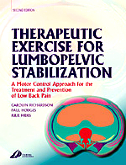-Contents-
SECTION 1: Introduction 1. The time to move forward SECTION 2: The
joint protection mechanisms Part 1 Introduction 2. Lumbo-pelvic
stability: a functional model of the biomechanics and motor control
Part 2 Specific joint protection of the spinal segments 3. Abdominal
mechanism and support of the lumbar spine and pelvis 4. Paraspinal
mechanism and support of the lumbar spine Part 3 The antigravity
muscle support system 5. Stiffness of the lumbo-pelvic region for
load transfer 6. The role of weightbearing and non-weightbearing
muscles SECTION 3: IMPAIRMENT IN THE JOINT PROTECTION MECHANISMS:
CONCEPTS 7. The deload model of injury 8. Joint injury 9. Pain models
SECTION 4 IMPAIRMENT IN THE JOINT PROTECTION MECHANISMS: LOW BACK
PAIN 10. Abdominal mechanism in low back pain 11. Paraspinal
mechanism in low back pain 12. Impairments in the muscles controlling
pelvic orientation and weightbearing SECTION 5 TREATMENT AND
PREVENTION OF LOW BACK PAIN 13. Principles of the ‘segmental
stabilization’ exercise model 14. Local segmental control 15. Closed
chain segmental control 16. Open chain segmental control and
progression into function
Author Information
Carolyn Richardson, PhD, BPhty (Hons), Associate Professor and
Reader, Department of Physiotherapy, University of Queensland,
Australia; Paul W. Hodges, PhD, MD (Neurosci), BPhty (Hons), NHMRC
Senior Research Fellow and Associate Professor, Department of
Physiotherapy, University of Queensland, Australia; and Julie Hides,
PhD, MPhtyST, Bphty, Clinical Supervisor, Department of
Physiotherapy, University of Queensland, Australia


